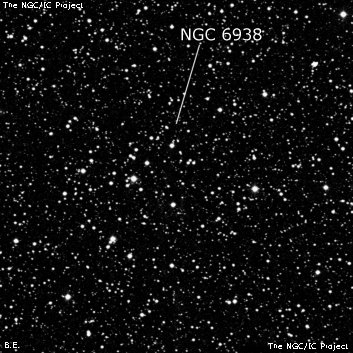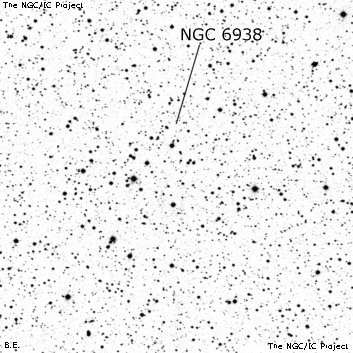NGC/IC Project Restoration Effort
(This is a very very beta version)
NGC6938


Basic Information
Location and Magnitude
Right Ascension: 20:34:42.0
Declination: +22:13:2
Constellation: VUL
Visual Magnitude:
Historic Information
Discoverer: Herschel W.
Year of discovery: 1784
Discovery aperture: 18.7
Observational
Summary description: Cl, vL, P, vlC
Sub-type: *Grp
Corwin's Notes
=====
NGC 6938. This original observations of this "cluster" by WH and JH are
confused enough that I've thrown in the towel and designated two different
groupings as the NGC object.
First, I note that the problems arise in the RA of the object; the NPD's and
declinations are reasonably consistent. JH uses his own position in GC, and
Dreyer follows along for NGC. Thus, NGC purists may wish to adopt JH's
cluster as the NGC object. This is the scattered group of stars more or less
at JH's position; he saw it twice, first in August 1827 and again just a year
later. He was not impressed with the field either time. On the first night
he only gives us an approximate NPD "68 23+-" and no RA with the comment,
"Very poor. The large star taken but carelessly, as it offers no interest".
The view on the second night enthused him only slightly more: He measured the
RA of the star, but again only estimated the NPD as "68 20+-", and noted,
"Place of the chief * 10 m of a coarse, poor, straggling, cluster." He also
misidentified the cluster as "VII. 17" rather than "VIII. 17" as it properly
is.
On the modern sky survey red images, there is a small core about 5 x 3
arcminutes at the eastern end of a larger elongated grouping roughly 18 x 8
arcminutes; both are elongated in the same position angle (about 105-110
degrees). I give the approximate position of JH's "* 10 m" as a stand-in for
more accurate positions for his cluster(s). On the blue POSS1, the small core
is southeast of the center of a poorly-defined, nearly circular grouping of
stars about 20 arcmin across.
WH's published position is from a single observation on 18 July 1784. For
publication, WH simply notes "A Cl of many L sc sts." In the sweep, he offers
us a more detailed description than he published: "A cl of sc stars more than
20' in diam, not very crowded and containing a great many large ones." All
this actually matches what we see on the sky at his published offset from 33
Vulpeclae, and is a different grouping of stars than JH saw 43 years later.
However, there are only two stars in the sweep, 33 Vul and 2 Peg. Though the
NPDs are consistent within the sweep, the RAs are not, with the suggested
clock corrections being over 1.2 minutes different. If instead of using 33
Vul as the reference star, we adopt 2 Peg, the RA becomes just 20 seconds
larger than JH's -- but the position lands well east of JH's cluster in a
relatively barren zone. Even so, I have to regard WH's RA as uncertain.
All in all, I'm just not sure which "cluster" actually is NGC 6938. This is
why I offer you the choice. If anyone can come up with something that I've
missed in this that might settle the matter, please let me know!
Steve's Notes
=====
NGC 6938
17.5" (8/19/85): at 220x there are 20 scattered stars in a 5' region with the brightest mag 9.2 SAO 88858. There are no richer spots and the stars are unevenly distributed into three distinct subgroups. Appears to be simply a poor asterism at 100x and 220x. Listed as nonexistent in RNGC.



